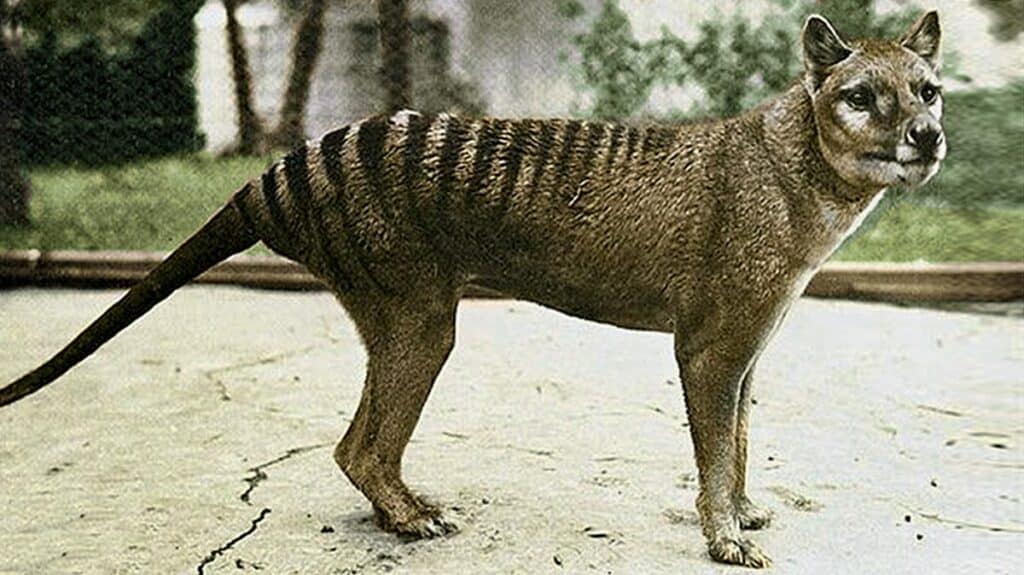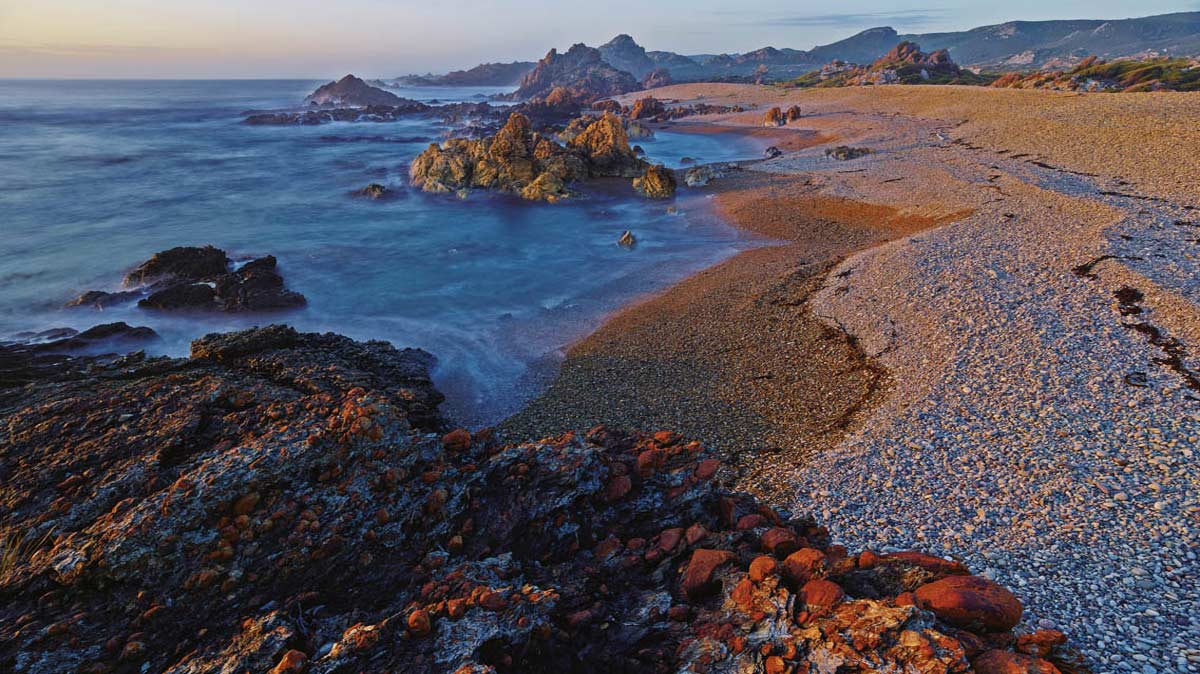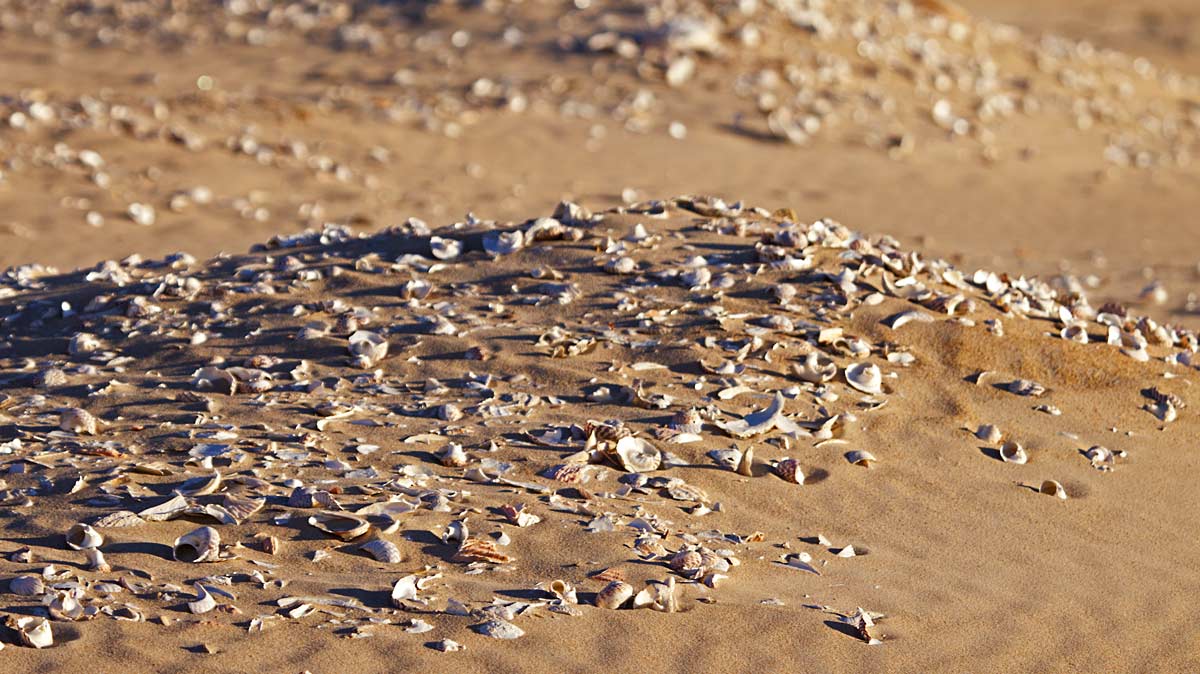Your eyes fix on a large fawn-coloured ‘dog’ with a stiff tail(Thylacine) — and dark stripes. Your spine tingles as you fumble hopelessly for your camera. Does the Tassie ‘tiger’ still stalk the Tarkine? Many claim to have seen it, but none has returned with more than a tiger tale. The officially extinct thylacine (Thylacinus cynocephalus, commonly called the Tasmanian tiger) has a spectral presence on the landscape, as if the place is still charged with its DNA. Perhaps the Tarkine has been guarding it all along. Keep your eyes peeled.
In 1893 a party of tourists surprised a ‘huge native tiger’ feeding on a wallaby carcass on the beach near Sandy Cape:
‘As [George] arrives within ten paces the animal turns quickly round, and, with flaming eyes and head covered with blood, charges straight at our karu. The axe…flies past [the ‘tiger’] harmlessly. George retires gracefully at the rate of knots. The tiger is gaining on him as we spring up and rush forward, yelling at the top of our voices. The beast…turns and faces us for a moment, but evidently thinking “discretion is the better part of valor” makes a bolt over the sand hills…leaving George wiping the perspiration from his face, caused by — well — by his violent exertion! How provoking that we had no gun.’
Tiger (Thylacinus cynocephalus, commonly called the Tasmanian tiger) shooting has long since ceased in the Tarkine. Because the most famous Tasmanian is officially extinct. There has not been one to poke, prod, feed and film since 1936. David Fleay’s footage of the last captive thylacine shows an enigmatic animal. This loping, endemic carnivore unnerved bushmen by ‘stalking’ them, yet it was shy and avoided people. Both male and female thylacine had a pouch, the male’s for protecting the genitals, the female’s for suckling young. When stationary, it rested on its hind legs like a kangaroo, and it is said to have started its run with a series of hops. The slow-moving thylacine wore down its prey, emitting a ‘yip yip’ sound during its relentless pursuit.
Its demise at European hands was swift. Accused of killing sheep on its favoured savannah woodlands, the thylacine was decimated by stockmen and bounty hunters. Introduced dogs and disease probably exacerbated its problems. Hundreds of thylacine bounties were paid in far north-western Tasmania. In 1906, for example, ‘Tiger Bill’ collected £1 from the government for every corpse he secured by snaring, poisoning and pursuit with dogs north of the Arthur River. In 1908 the Temma Hotel advertised tiger shooting to ‘tourists in search of fun’.
The result of such attention is that an animal roaming Australia and New Guinea in pre-European times has been confined to cameo performances for a century — generally with the aid of a taxidermist. In 1937, when the rare marsupial had finally been protected, the land between the Arthur and Pieman Rivers was proposed as a thylacine sanctuary. It was thought that retreat into the thick forest bordering its feeding grounds would offer it protection.
Perhaps thylacinus has enjoyed the unofficial sanctuary of the forest. In 1961 a fisherman claimed to have killed one in a hut near Sandy Cape. The corpse mysteriously disappeared after allegedly being left under a sheet of iron. A thylacine body was found five years later — a spectacularly well-preserved 5,000-year-old tiger ‘mummy’ in Thylacine Hole Cave near Western Australia’s Nullarbor Plain. Locals still vouched for a living Tarkine population. ‘Credible’ sightings have continued without physical evidence being produced. The final thylacine ‘bounty’ — the reward for proof of its survival — has never been paid.
Today the tiger stalks the Tasmanian conscience — through official insignia, artwork and merchandising. Tasmanians drink tiger beer, read tiger books, ride tiger bicycles, play tiger video games and barrack for tiger teams. While the Jurassic Park science of re-creating the tiger from its DNA is being explored, ‘sightings’ of existing animals continue — and well beyond Tasmania. Has collective guilt turned the tiger into another urban mythological ‘big cat’? The world desperately needs the thylacine. Perhaps the Tarkine has been guarding it all along. Keep your eyes peeled.




